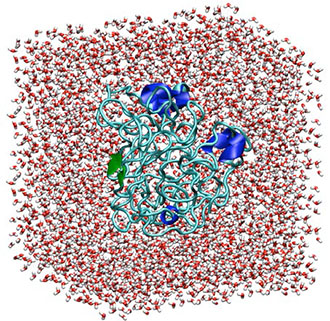
Figure 5. Polyalanine (2593 atoms) solvated in water with a total of 19,945 atoms. In the graphic, white represents hydrogen atoms and red represents oxygen in the solvating water molecules. Blue and green represent polyalanine.
The editors of The Journal of Chemical Physics annually select a few articles that present significant and definitive research in experimental and theoretical areas of chemical physics. Lab researchers and a collaborator authored the paper, “Graph-based Linear Scaling Electronic Structure Theory,” which the editors selected in the area of Theoretical Methods and Algorithms.
The importance of electronic structure theory in materials science, chemistry, and molecular biology relies on the development of theoretical methods that provide sufficient accuracy at a reasonable computational cost. The immense promise of linear scaling electronic structure theory has never been fully realized due to some significant shortcomings: 1) the accuracy is reduced to a level that is often difficult, if not impossible, to control; 2) the computational pre-factor is high, and the linear scaling benefit occurs only for very large systems that in practice often are beyond acceptable time limits or available computer resources; and 3) the parallel performance is generally challenged by a significant overhead, and the wall-clock time remains high even with massive parallelism. All these problems coalesce in quantum-based molecular dynamics simulations, which constrain calculations to small system sizes or short simulation times. The team overcame these shortcomings by demonstrating how graph theory can be combined with quantum theory to calculate the electronic structure of large complex systems. Graph theory studies graphs, the mathematical structures used to model pairwise relations between objects. The formalism is general and applicable to a broad range of electronic structure methods and materials, including challenging systems such as biomolecules. The methodology combines well-controlled accuracy, low computational cost, and natural low-communication parallelism. This combination addresses substantial inadequacies of linear scaling electronic structure theory, in particular with respect to quantum-based molecular dynamics simulations.
The researchers used a test system for the analysis that is based on a 19,945 atoms system of polyalanine (2593 atoms) in liquid water. The team chose alanine because it is possibly the simplest chiral amino acid that enables the formation of stable secondary structures. Investigators can build models with this simple peptide that include linear, α-helix, and β-sheet polyalanine secondary structures, which introduce extra complexity to the system. These secondary structures and complexity are needed to test the graph-based electronic structure framework. The density of the final globular structure is around 0.7 g/ml, which is a reasonable value for globular proteins.
Reference: “Graph-based Linear Scaling Electronic Structure Theory,” The Journal of Chemical Physics 144, 234101 (2016); doi: 10.1063/1.4952650. Authors: Hristo Djidjev, Susan Mniszewski, and Michael Wall (Information Sciences, CCS-3); Nicolas Bock and Jamal Mohd-Yusof (Applied Computer Science, CCS-7); Marc Cawkwell, Timothy Germann, Christian Negre, and Anders Niklasson (Physics and Chemistry of Materials, T-1); Pieter Swart (Applied Mathematics and Plasma Physics, T-5); and Emanuel H. Rubensson (Uppsala University).
The DOE Office of Science, Office of Basic Energy Sciences funded the underlying theory, basic concepts, and simple initial proof. The Laboratory Directed Research and Development (LDRD) program sponsored the computer science and platform specific optimization using the graph partitioning tool. The research used resources from LANL’s Institutional Computing Program. The work supports the Lab’s Energy Security mission area and the Information, Science, and Technology and the Materials for the Future science pillars. Technical contact: Susan Mniszewski
